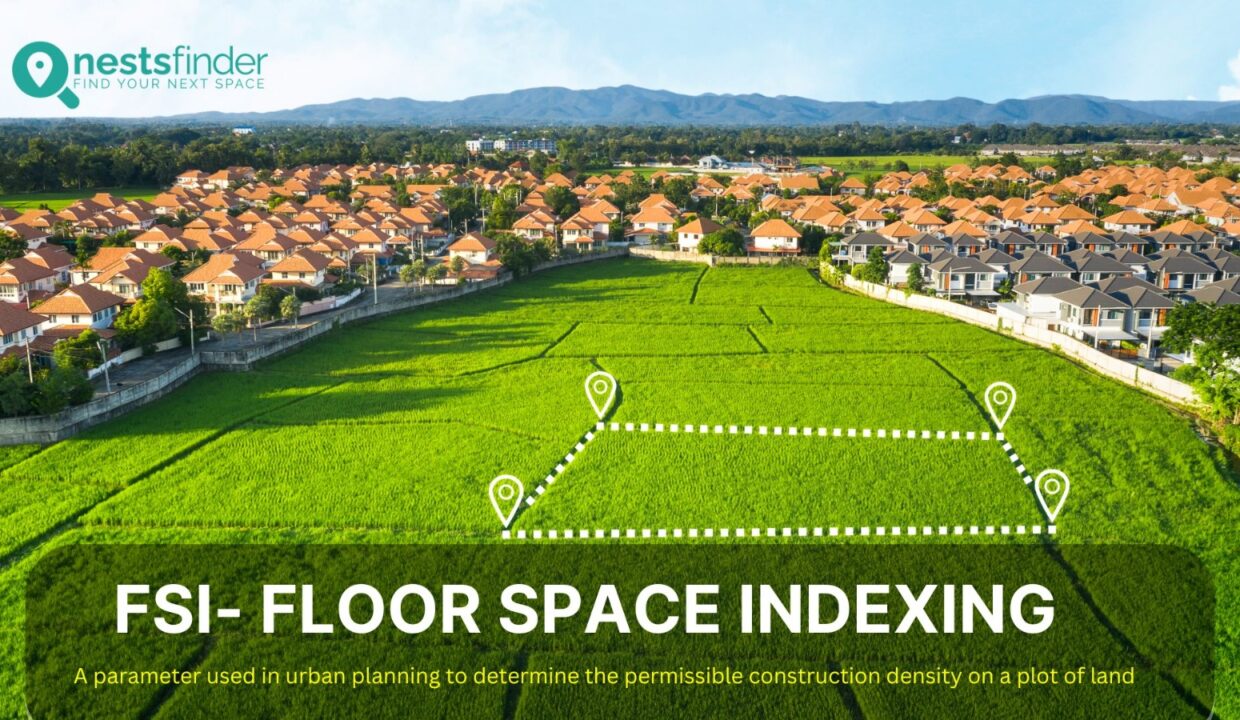Floor space index (FSI) : Meaning, Calculation & Importance
Floor Space Indexing (FSI) is one of the most important terminologies in real estate . Understanding real estate terminologies is important when navigating the complicated world of property. It enables people to make informed judgements , negotiate successfully and avoid expensive mistakes. One of the most important concepts in real estate is Floor Space Index( FSI) also known as Floor Area Ratio( FAR).
The Floor Space Index(FSI) is the ratio of building’s total floor area to the size of the land on which it stands. It is essential for determining a property’s density and development potential. FSI can also be classified as premium FSI, which provides additional construction rights for a charge. The FSI calculation determines the maximum amount of construction permitted on a given site. As a result, efficient land utilisation is achieved while complying to zoning restrictions and infrastructure capacity.
Understanding FSI and its effects is important for investors, developers, and buyers . This information assists in evaluating a property’s potential, sticking to building codes, and making informed judgements.
For example, if a plot has an FSI of 2, it means that the building’s total floor area cannot be more than twice the plot’s size. This limit helps in avoiding excessive construction and contributes to a harmonious urban environment.
Floor Space Index (FSI) plays a critical role in urban planning and zoning rules. It guarantees that buildings are built in conformity with existing infrastructure and resources, such as water, power, and transportation facilities . Developers that follow FSI requirements can help to promote sustainable and well-planned urban development.
How is Floor Space Index (FSI) Calculated?
Once you’ve figured out what FSI is, the next obvious step is to learn how to calculate it for a property. However, before learning how to calculate FSI, keep in mind that the floor space index is often reported as a percentage, whereas the floor area is typically expressed as a ratio. In terms of the floor space index, a floor area ratio of 1.4 equals 140 percent.
The FSI calculation is done by dividing the Total covered area on all floors by the total area of the plot.
Let’s assume that you have a 500 square metre plot of land and a total covered space of 750 square metres across all floors of the structure. To calculate the FSI, divide 750 (total covered area) by 500 (plot area).
FSI = 750/500 square metres equals to 1.5
The FSI for this case is 1.5. This indicates that the overall floor space of the building should not be more than 1.5 times the size of the plot. If the FSI allowed by local regulation is 2 , the building can be built further to maximise the available FSI.
Factors affecting FSI
The Floor Space Index (FSI) is impacted by a number of criteria that determine the maximum allowable building on a piece of land. Here are five main characteristics that influence FSI:
Zoning Rules
Local authorities’ zoning rules play an important role in determining FSI. These rules specify the permitted land use, building setbacks, height restrictions, and FSI limits for specific zones or locations. The FSI computation is impacted by the zoning restrictions that apply to a given site.
Infrastructure Capacity
FSI also affects the availability and capacity of infrastructure systems. This includes systems like water supply, sewage, transportation networks, and public amenities. Authorities consider the infrastructure’s ability to support additional construction. Then it determines the impact on the nearby area when deciding the FSI limits.
Environmental considerations
Open space regulations, ecological areas, and environmental impact can all have an impact on FSI. Authorities may apply restrictions or increase FSI to guarantee environmental sustainability and conserve natural resources.
Road Width and Setbacks
The width of adjacent roads as well as building setbacks can have an impact on FSI. Narrower roadways or bigger buffers may result in lower FSI restrictions. This would ensure proper circulation, parking, and access to the building, but larger roads could allow for higher FSI.
Building Types and Functions
The kind and purpose of the building might have an impact on Floor Space Index (FSI) . Residential, commercial, industrial, and institutional buildings may have varied FSI restrictions depending on local regulations. For example, higher FSI may be allowed for commercial buildings than residential units.
Conclusion
Understanding FSI is critical for everyone working in the real estate industry. It gives information about development possibilities, regulatory compliance, and the most efficient use of available property. Understanding all parts of the subject ‘What is FSI’ makes it easier to make informed judgements, contribute to sustainable urban development, and meet real estate objectives.
Do you want expert guidance on real estate investments? Contact Nestsfinder today to receive personalised advice and assistance in making informed property selections. Nestsfinder is Dehradun’s premier real estate developer, offering a diverse range of properties throughout Dehradun .




